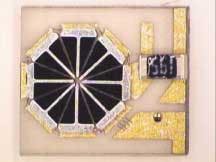Light powers electric-field probe
Some electronic devices can produce electric fields (E-fields) within the human body. These fields arise either unintentionally (for example, from the use of mobile phones and other electronic devices) or intentionally (heating of tissue by radio-frequency electromagnetic fields to kill cancerous tumors). Accurately characterizing these fields can only be done with a probe that can be inserted into either the human body itself or a suitable simulation. But the optoelectronics needed for such a probe require electrical power, which can muddy the very fields the probe is trying to measure.
An E-field probe developed by researchers at the Technical University of Berlin (Berlin, Germany) solves the interference problem by piping power to the probe in the form of light transmitted by an optical-fiber bundle, using photovoltaic cells on the probe to convert the light to electricity (see figure). To measure the E-field itself, the probe contains a vertical-cavity surface-emitting laser (VCSEL) that is modulated by the E-field. Light from the VCSEL is sent over a second optical fiber to a remote sensor.
A 2.4-mm-diameter glass-fiber bundle carries the light from a 35-W metal-halide lamp to the device. The laser itself is modulated by E-fields at frequencies up to 1 GHz. Frequency-response measurements in the 70- to 350-MHz range were carried out in water. The probe can measure 100-MHz field strengths up to about 160 V/m in a linear fashion.
An electric-field probe measures field amplitude and phase in aqueous media like the human body; the probe has no outside electrical connections. Power in the form of light is piped to the probe via optical fiber. The light is converted to electricity by an array of eight silicon solar cells shaped like pie slices and connected in series. Two electrodes (thin gray stripes at top and bottom of probe) detect the field and modulate a vertical-cavity surface-emitting laser (round spot on metallized area at lower right of probe). Light from the laser is transmitted via optical fiber to an outlying sensor.
Although the probe was first designed to characterize treatment of tumors by heating, another application is that of electromagnetic compatibility, particularly radiation safety of mobile phones, according to Wieland Mann, one of the researchers. "For this, the probe is directly inserted into a model, or phantom, of the human body—especially the head—while the phantom is exposed to electromagnetic waves," he says. The researchers are testing versions of the probe with higher sensitivity, smaller sizes, integrated preamplifiers, and three-dimensional probes, Mann notes.
Reference
- W. Mann and K. Petermann, Elect. Lett. 9 (May 2002).

